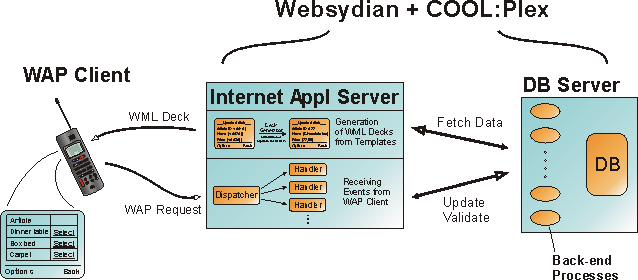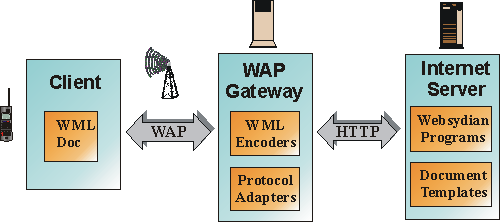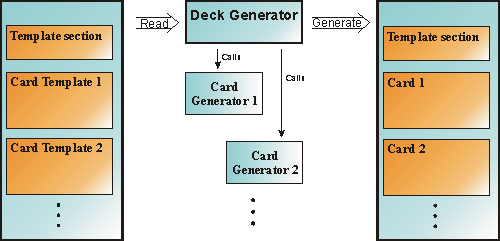|
|
Users Guide | Patterns Reference | WebsydianExpress | Search |
|
|
Users Guide | Patterns Reference | WebsydianExpress | Search |
This document gives a short presentation to the Websydian Enterprise WAP module which fully supports development of Enterprise WAP applications
Neither this document or the rest of the Websydian Enterprise WAP Documentation Set tries to explain the WAP protocol or the WML markup language - the documentation rather explains how WAP applications are implemented with Websydian. The official WAP reference documentation can be downloaded from http://www.wapforum.org/what/technical.htm.
WAP (Wireless Application Protocol) is a communication protocol that makes it possible to implement and run connected applications on small handheld computers, e.g. on cellular telephones.
Websydian has been extended to fully support development of WAP applications. By using Websydian, it is now possible to build WAP applications which access and update your server databases.
Websydian Enterprise WAP has (just like Websydian for HTML) been designed for efficiency of development. Within one development environment, you can specify your entire WAP application including generation of dynamic WML documents (Decks), receiving WAP requests, and specifying application server logic accessing and updating the database.
Websydian Enterprise WAP allows you to focus on your business instead of technology. The Websydian patterns efficiently hide away the underlying protocols, API’s and detailed WML syntax providing you with a pure AllFusion Plex development environment. And, additional high-level WAP Utility patterns will make you even more productive.

Using Websydian Enterprise WAP it is possible to design and implement integrated WAP application within a single development environment.
If you already know Websydian, but you are new to WAP it will be easy for you to get started with WAP development. You may choose to take the following path through the documentation.
If you are new to Websydian, you will also have to study parts of the Websydian documentation. Get comfortable with the Websydian Circle and the process of generating Documents from Templates. Do also read about the Websydian main functions (Dispatcher, Event Handler, Page Generator, Document Template Generator).
If you are new to AllFusion Plex, it is strongly recommended that you start on by getting some basic experience with AllFusion Plex. Understanding the Websydian Documentation requires at least some knowledge about the AllFusion Plex concepts and development environment.
The WAP protocol maps very well to the HTTP protocol that is used for internet communication. In a typical WAP application, the WAP client communicates with a WAP/HTML gateway which in turn communicates with an Internet Application server.

WAP requests are sent from the Client (e.g. a cellular telephone) to a WAP gateway through the telephone net. From the WAP Gateway, the request is routed on to the Internet Application Server to be received as a normal HTTP request. Similarly, WML documents are generated at the Internet Server and sent back to the Client through the WAP Gateway.
Generated WML documents are submitted to services provided by the HTTP protocol and forwarded to the client through the WAP gateway, while the client will submit HTTP requests to the Internet application server through the gateway. The WAP protocol itself supports low-bandwidth communication by removing a lot of the overhead introduced by the HTTP protocol.
By using Websydian, the WAP protocol is made transparent to the developer. Websydian supports generation of WML documents as well as receiving WAP client requests. In this way, all development is done in a single AllFusion Plex/Websydian environment where the developer does not need to concentrate about low-level technology. In the same way, the developer writes programs with no regard to whether the application will be installed on an NT or iSeries Internet application server communicating with an NT or iSeries database server.
WAP operates with WML (Wireless Markup Language) which very much looks like HTML just designed for low-bandwidth, small display devices. WML documents are displayed by a micro-browser implemented by mobile WAP telephones or by other handheld WAP devices in the same way as normal HTML documents are displayed by a Web browser. WML documents can be displayed by a number of different devices which may vary considerably in size – the smallest displays being no larger than 5x20 characters.
Experience has shown that different WAP devices often interpret WML differently and some devices still do not fully support the WML standard. In addition, the WML language is very sensitive compared to HTML. For instance, all keywords must be lower-case and elements are often not displayed if they contain small syntax errors (e.g. a table missing a cell).
WML documents are sent to the WAP client as WML Decks where each Deck contains one or more WML Cards. The Deck comprises the entire tagged document sent to the browser while a Card is what is displayed by the WAP browser window. In this way, the user can jump between the different Cards within a Deck without accessing the server.
How Does Websydian Enterprise WAP WorkAll basic principles in Websydian for HTML have been applied in Websydian Enterprise WAP. The substitution of replacement markers by Page Generator functions is the same though some additional features have been added (see below). The WAP Event Handler and Dispatcher patterns are also used in the same way as the corresponding patterns in Websydian for HTML.
The syntax of WML is different from the syntax of HTML. Therefore, a WML Deck Template Generator has been implemented in addition to the current HTML Document Template Generator. In addition, a Card Generator and a Jump pattern have been applied in order to reflect the structure and constructs of WML.
The generation of WML pages (Decks) for WML browser are based on Templates in exactly the same way as the generation of HTML pages in Websydian. In Websydian Enterprise WAP, the Page Generator is now called a Deck Generator and the Document Templates are called Deck Templates.

WML Decks shown in a WAP browser are generated from Deck Templates. During the generation of a WML Deck, all replacement markers in the template are substituted with data values.
In Websydian Enterprise WAP, WML generation is split between a Deck Generator and one or more Card Generators (one Card Generator for each Card in Deck). The Deck Generator generates the Deck portion of the WML document and it then calls Card Generators to generate the Card portions.

The Deck Generator delegates control to Card Generators to generate the Card portion of each WML Card in the Deck.
Deck Generators as well as Card Generators are Page Generator functions (as known from standard Websydian) and both kind of functions are specified as separate function objects in the AllFusion Plex model.
During the WML generation, the same Deck Template is used and only one WML document is generated – though several generator functions have been involved in the generation process. By having separate functions for Deck and Card generation, the Deck/Card structure of WML is directly reflected in the architecture of Websydian.
The Websydian Enterprise WAP Documentation Set contains the following main sections: